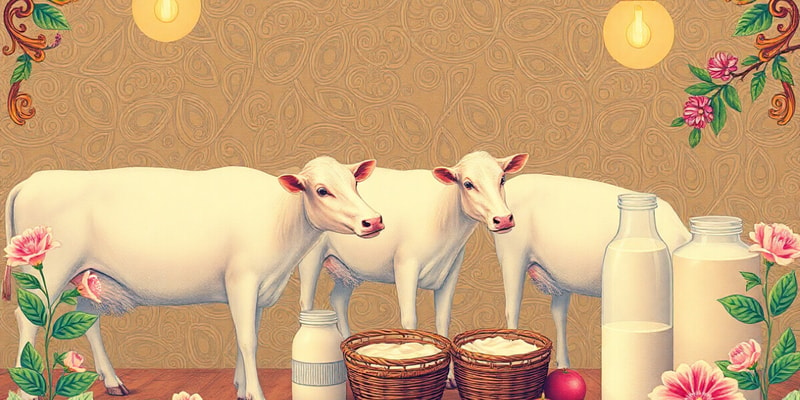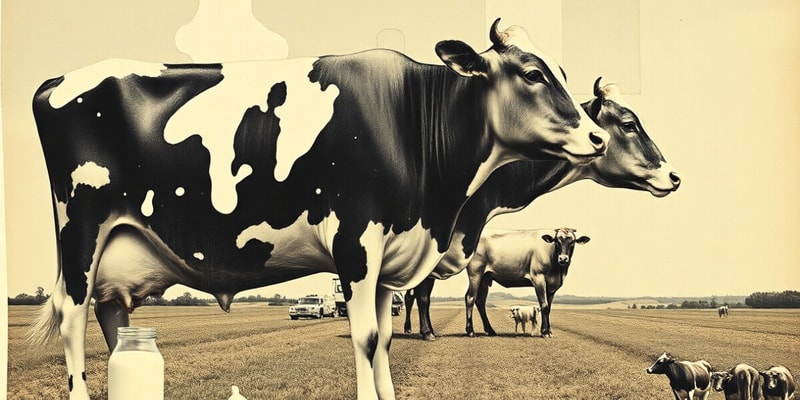Podcast Beta
Questions and Answers
Which breed of dairy animal has the highest fat content in its milk?
What is a common by-product of cheese production?
Which of the following is NOT considered a milk product?
Which milk product is created by combining skim milk powder with water and vegetable oil?
Signup and view all the answers
Which type of milk contains the least lactose?
Signup and view all the answers
What is a typical use for whey, a by-product of cheese?
Signup and view all the answers
Which dairy product is produced by fermenting milk?
Signup and view all the answers
Which of the following contains the highest protein percentage?
Signup and view all the answers
Which breed has the highest average daily milk production?
Signup and view all the answers
What is the average butterfat percentage for the Jersey breed?
Signup and view all the answers
Which tropical breed has the highest average female weight?
Signup and view all the answers
Which selection criteria primarily evaluates the overall shape and function of the dairy cow?
Signup and view all the answers
What is a key factor to consider when assessing milk yield in dairy cattle?
Signup and view all the answers
Which breed has the lowest average daily milk production based on the provided data?
Signup and view all the answers
What is an important attribute of dairy character as per selection criteria?
Signup and view all the answers
Among the breeds listed, which has the highest lactation period variation?
Signup and view all the answers
Which of the following breeds is known for its high milk production but has the lowest milk fat content?
Signup and view all the answers
Which breed is characterized by its excellent grazing ability and large size, while also being desirable for beef and veal?
Signup and view all the answers
Which tropical breed is noted for its heat tolerance and high milk fat content?
Signup and view all the answers
What is a common undesirable trait of both the Guernsey and Jersey breeds?
Signup and view all the answers
Which breed is often described as the most gentle of Zebu breeds?
Signup and view all the answers
Which dairy breed is known for its excellent fertility and early maturity, making it easier to manage?
Signup and view all the answers
What is a shared undesirable trait of both Brown Swiss and Ayrshire breeds?
Signup and view all the answers
Which breed is associated with producing yellow milk and is known for high milk fat content?
Signup and view all the answers
Which dairy breed is characterized as hardy but can be wild without consistent human handling?
Signup and view all the answers
Which of the following breeds is least desirable for beef and veal production?
Signup and view all the answers
Study Notes
Status of Dairy Industry
- The dairy industry covers topics such as breeds and selection, housing and equipment, nutrition, care and herd management, breeding and reproduction, herd health programs, and animal products and by-products.
Milk Products
- Milk is considered a complete food.
- Cows, buffaloes, and goats provide different milk compositions.
- Milk products include whole milk, pasteurized, sterilized, flavored milk, ice cream, cheese, milk powder, cream, skim milk, milk confection, infant milk powder, yogurt, fermented milk, evaporated milk, condensed milk, sweetened milk, butter, buttermilk, butter oil, coffee cream, salad cream, whey, and beverages.
Dairy Breeds
- Temperate breeds thrive in colder climates (-1 – 10ºC).
- Tropical breeds thrive in warmer climates (10 – 27ºC).
Temperate Breeds
-
Ayrshire
- Originates in Scotland
- Desirable traits include hardiness, grazing ability, style, symmetry, strong udder attachment, and a smooth, clean dairy type.
- Undesirable traits include nervousness, fair beef and veal rating, and lack of heat tolerance.
-
Brown Swiss
- Originates in Switzerland
- Desirable traits include hardiness, grazing ability, large size, desirable for beef and veal, docility, high milk volume, high milk fat and solids percentages.
- Undesirable traits include stubbornness and lack of heat tolerance.
-
Guernsey
- Originates in the Channel Islands
- Desirable traits include docility, high milk fat and total solids content, and yellow milk.
- Undesirable traits include yellow body fat, small size, undesirable for veal and beef production, and lack of heat tolerance.
-
Holstein Friesian
- Originates in the Netherlands
- Desirable traits include highest milk production, good size, fast growth, good carcass, and desirable for beef and veal.
- Undesirable traits include lowest milk fat and lack of heat tolerance.
-
Jersey
- Originates in the Channel Islands
- Desirable traits include large amounts of milk fat, uniformity in type, and yellow milk.
- Undesirable traits include yellow body fat, small size, undesirable for veal and beef production, and lack of heat tolerance.
-
Milking Shorthorn
- Originates in England
- Desirable traits include ease of management, calving ease, longevity, early maturity, excellent fertility, and large quantities of milk.
- Undesirable traits include genetic defects, lack of heat tolerance, and low prices for white and roan animals.
Tropical Breeds
-
Gir/Gyr
- Originates in India
- Desirable traits include hardiness, high fertility, good calving ease, and a gentle temperament.
- Undesirable traits include low milk production.
-
Sahiwal
- Originates in Pakistan
- Desirable traits include heat tolerance, high milk fat, and resistance to parasites and diseases.
- Undesirable traits include low milk production and lack of cold tolerance.
-
Red Sindhi
- Originates in Pakistan
- Desirable traits include heat tolerance, resistance to parasites and diseases, and fertility in warm temperatures.
- Undesirable traits include low milk production.
-
Tharparkar
- Originates in Pakistan
- Desirable traits include hardiness, a dual purpose breed, and disease resistance.
- Undesirable traits include low milk production and potential wildness with lack of human handling.
Data Comparison of Temperate Breeds in the Philippines
-
Holstein Friesian
- Average male weight: 818 kg
- Average female weight: 568 kg
- Average daily milk production: 22 kg
- Average butterfat: 3.6%
- Average lactation period: 300 days
-
Jersey
- Average male weight: 636 kg
- Average female weight: 431 kg
- Average daily milk production: 13 kg
- Average butterfat: 5.2%
- Average lactation period: 300-365 days
-
Brown Swiss
- Average male weight: 909 kg
- Average female weight: 591 kg
- Average daily milk production: 17 kg
- Average butterfat: 4.0%
- Average lactation period: 300-365 days
Data Comparison of Tropical Breeds in the Philippines
-
Sahiwal
- Average male weight: 540 kg
- Average female weight: 370 kg
- Average daily milk production: 8 kg
- Average butterfat: 4.9%
- Average lactation period: 300 days
-
Red Sindhi
- Average male weight: 415 kg
- Average female weight: 310 kg
- Average daily milk production: 6 kg
- Average butterfat: 4.9%
- Average lactation period: 275 days
-
Tharparkar
- Average male weight: 540 kg
- Average female weight: 385 kg
- Average daily milk production: 6 kg
- Average butterfat: 4.3-6%
- Average lactation period: 268 days
-
Gyr
- Average male weight: 545 kg
- Average female weight: 385 kg
- Average daily milk production: 6 kg
- Average butterfat: 4.5%
- Average lactation period: 245 days
Hybrid Breeds
-
Holstein Sahiwal
- Hybrid breed produced by crossbreeding the Holstein Friesian and Sahiwal breeds.
-
Philstein
- Another hybrid breed resulting from the crossbreeding of the Holstein and Sahiwal breeds.
-
PhilSey
- Hybrid breed result of crossbreeding Jersey and Sahiwal breeds.
Selection of Dairy Animals
-
Records:
- Emphasize animal's own records, its pedigree, and progeny records.
- Key areas of focus include milk yield, fertility, growth rates, and health status.
- Records enhance the selection process.
-
Physical Qualities:
- Selection should consider health, absence of abnormalities, good dairy temperament, and dairy type conformation.
- Physical evaluation is essential for selecting dairy animals, especially when records are lacking.
Physical Qualities of Dairy Cow: Udder and Body Condition
-
Udder:
- Large and well-developed
- Uniform size and functional teats
-
Body Condition Score:
- A numerical assessment ranging from 1 to 5 (or 1 to 9), indicating the amount of fat reserves in the animal.
- A score of 3 is considered ideal for dairy cows, indicating optimal body condition for milk production and overall health.
Selection Criteria for Dairy Cattle
-
General Appearance:
- Milkiness (appearance of being well-suited for milk production).
- Feminine refinement (delicate features and a feminine body frame).
- Symmetry (balanced proportions).
- Balance of body and mammary system (harmonious development of the body and udder).
- Barrel capacity (deep and wide chest and rib cage).
- Straight long back and topline (Indicates longevity for milking).
-
Dairy Character:
- Angular body, lack of beefiness (absence of excessive muscling, typical of dairy breeds)
- Desirable body traits for dairy cattle.
-
Dairy type conformation:
- Desirable conformation features that contribute to milk production efficiency.
- These details include features related to the udder, legs, and overall body structure.
Record Keeping
- Pedigree: A lineage chart that traces the ancestry of an animal. It provides information on the animal's genetic background.
- Progeny: Refers to the offspring or descendants of an animal. Progeny records are valuable in evaluating the milk production potential of a sire (male) or dam (female) animal.
Studying That Suits You
Use AI to generate personalized quizzes and flashcards to suit your learning preferences.
Related Documents
Description
This quiz explores the various aspects of the dairy industry, including dairy breeds, milk products, and management practices. Test your knowledge on the selection, care, and nutrition of dairy animals, as well as the diverse products derived from milk. Perfect for students and enthusiasts of agricultural sciences.




